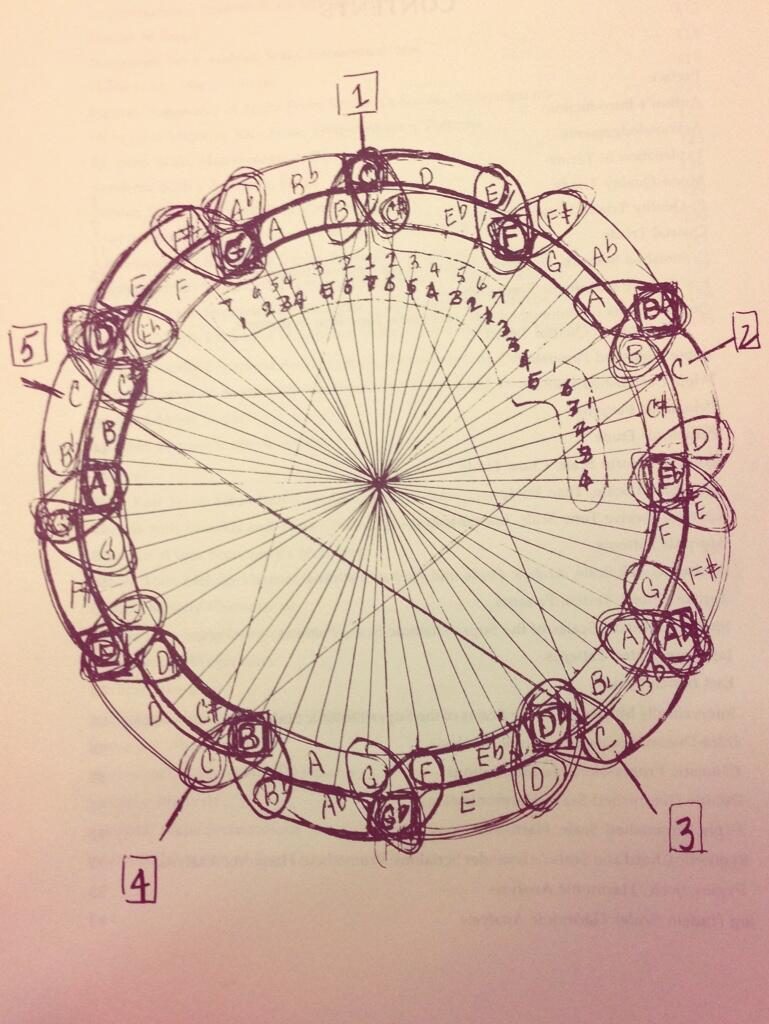John Coltrane: How Jazz Became a Mathematical and Spiritual Journey

John Coltrane’s famous circle diagram, given to Yusef Lateef in 1967, illustrates the mathematical relationships in his music theory.
A saxophone wails in the darkness. A man hunches over his instrument, eyes closed, fingers dancing across the keys in patterns that seem almost algorithmic. This is John Coltrane, and he isn’t just playing jazz—he’s unraveling the mathematical fabric of the universe through sound.
For Coltrane, music wasn’t just an art form; it was a mathematical construct with spiritual implications—a lens through which one could glimpse the divine. His approach to jazz transformed the genre from pure emotional expression into a complex system of mathematical relationships that resonated with cosmic truths.
“I want to be the force which is truly for good. I want to be a force which represents something that isn’t purely physical, a force that represents something just as spiritual. Therefore, the highest purpose of music is to reach that force.” — John Coltrane
In this article, we’ll explore how Coltrane’s groundbreaking approach to music merged mathematical precision with spiritual seeking, creating a revolutionary musical language that continues to influence musicians and thinkers across disciplines.
Quick Navigation
The Circle Theory: Coltrane’s Mathematical Framework
In 1967, John Coltrane gave saxophonist Yusef Lateef a hand-drawn diagram that would later become known as the “Coltrane Circle.” This deceptively simple drawing wasn’t just a music theory sketch—it was a mathematical blueprint for understanding harmony in a revolutionary way.

Coltrane’s circle connects musical intervals with geometric precision, revealing the mathematical underpinnings of his compositions.
The diagram consists of two concentric circles divided into 12 equal parts, representing the 12 tones of the chromatic scale. But Coltrane’s innovation was in how he connected these points, revealing mathematical relationships between tones that traditional Western music theory had overlooked.
What makes this diagram remarkable is how it marries the precision of geometry with musical intervals:
- The outer circle of notes moves chromatically clockwise
- The inner circle of tones moves counterclockwise
- The diagram reveals symmetrical patterns that can be used to generate complex chord progressions
- It illustrates how Coltrane could navigate through multiple key centers with mathematical precision
- The geometric relationships mirror principles found in sacred geometry and mystical traditions
Musicians and mathematicians alike have studied this diagram for decades, finding in it connections to everything from the Fibonacci sequence to ancient Greek concepts of musical harmony. The diagram illustrates how Coltrane approached music not just as an emotional expression but as a mathematical puzzle to be solved.
Giant Steps: Musical Mathematics in Action
Perhaps nowhere is Coltrane’s mathematical approach more evident than in his 1960 composition “Giant Steps.” This piece is considered one of the most challenging jazz standards due to its rapid chord changes and unusual harmonic progression—a progression derived directly from mathematical principles.
The Coltrane Changes: A Mathematical Structure
The “Coltrane Changes” in Giant Steps divide the octave into three equal parts, creating a series of key centers separated major thirds. This creates a symmetrical division of the 12-tone scale that was revolutionary in jazz harmony.
The colored keys represent the three key centers in Giant Steps, separated major thirds (4 semitones).
Mathematically, Coltrane’s Giant Steps progression divides the octave into three equal parts (major thirds), creating a symmetrical structure. This approach is similar to concepts in modular arithmetic and group theory in mathematics—fields that study patterns and symmetries.
“What Coltrane did in Giant Steps was to superimpose one harmonic pattern (the cycle of major thirds) onto another (the cycle of fifths), creating a complex mathematical structure that still sounds musical.”
The rapid chord changes in Giant Steps—often at the rate of two per measure—create a harmonic maze that requires improvisers to think algorithmically rather than emotionally. This approach transformed jazz improvisation from pure intuition to something closer to mathematical problem-solving.
A Love Supreme: The Spiritual Dimension
For Coltrane, mathematical precision in music wasn’t just an intellectual exercise—it was a spiritual quest. His 1965 masterpiece “A Love Supreme” represents the perfect fusion of his mathematical approach with his deepening spiritual beliefs.
After overcoming heroin addiction in the late 1950s, Coltrane experienced a spiritual awakening that profoundly affected his music. He began to see musical patterns as reflections of divine patterns in the universe, similar to how ancient Pythagoreans viewed mathematical ratios as expressions of cosmic harmony.
The Numerology of “A Love Supreme”
- The album’s four-part structure mirrors many spiritual frameworks across cultures
- The main four-note motif (which can be sung as “A Love Su-preme”) is transformed mathematically throughout the composition
- The rhythmic patterns follow mathematical sequences that create a meditative effect
- The harmonic structure moves through a series of mathematical transformations that mimic spiritual progression
Coltrane studied the sacred texts of multiple religions, including Christianity, Hinduism, Buddhism, and Islam, as well as the mathematical writings of Pythagoras and other ancient scholars. He began to see connections between mathematical patterns in music and spiritual concepts of universal harmony.
“My goal is to live the truly religious life, and express it in my music. My music is the spiritual expression of what I am – my faith, my knowledge, my being.” — John Coltrane
In his later years, Coltrane’s music became increasingly focused on this spiritual-mathematical synthesis. Works like “Interstellar Space” and “Ascension” pushed even further into explorations of sound as mathematical patterns that could reveal spiritual truths—creating music that was simultaneously highly intellectual and deeply mystical.
Sheets of Sound: Harmonic Density
In the mid-1950s, critic Ira Gitler coined the term “sheets of sound” to describe Coltrane’s playing style—a technique that unleashed cascades of notes in rapid succession. This wasn’t just virtuosic display; it was a mathematical approach to expanding harmonic possibilities.
The “sheets of sound” technique involves playing the notes of a chord so rapidly that they’re perceived almost simultaneously rather than sequentially. This creates a harmonic density that can be understood through the mathematical concept of superposition—multiple states existing in the same space.
Mathematical Aspects of “Sheets of Sound”
- Notes are clustered in mathematical groupings, often based on pentatonic or hexatonic scales
- The speed of execution creates a harmonic effect similar to what mathematicians call “wave superposition”
- The technique allows for exploration of harmonic relationships that can only be implied rather than stated directly
- Coltrane often used mathematical patterns in these runs, such as sequences based on specific intervals
What’s remarkable about Coltrane’s sheets of sound is that they’re not random or purely emotional expressions—they follow clear mathematical patterns. Musicians who have transcribed these passages have discovered intricate mathematical relationships between the notes, showing that even in his most seemingly chaotic moments, Coltrane was thinking with mathematical precision.
This approach to creating harmonic density through mathematical clustering of notes has influenced generations of musicians across genres, from jazz saxophonists to electronic music producers who use similar principles to create textural complexity in their compositions.
The Ongoing Legacy
John Coltrane’s mathematical-spiritual approach to music continues to resonate well beyond the world of jazz. His innovations have influenced fields as diverse as physics, computer science, and spiritual studies.
Impact on Music Theory
Contemporary music theorists continue to analyze Coltrane’s mathematical approaches, finding connections to advanced concepts in group theory and symmetry. His circle diagram has become a standard study tool for advanced jazz education.
Algorithmic Composition
Coltrane’s mathematical frameworks have inspired the development of algorithmic composition tools that use similar principles to generate complex harmonic progressions and melodic patterns.
Physics Connections
Physicists have noted similarities between Coltrane’s musical mathematics and concepts in quantum mechanics and wave theory, particularly in how his music explores the relationship between discrete elements and continuous phenomena.
Spiritual Studies
Religious scholars and spiritual seekers continue to find in Coltrane’s music a model for how mathematical patterns can serve as a gateway to spiritual awareness and transcendence.
Perhaps most remarkably, the Coltrane Church (officially the St. John Coltrane African Orthodox Church) was founded in San Francisco in 1971, using Coltrane’s music and philosophy as a central element of its worship. The church sees his mathematical-spiritual synthesis as a path to divine understanding.
Across disciplines, Coltrane’s work continues to inspire those looking to understand how mathematical structures can reveal deeper truths about reality. His legacy demonstrates how rigorous intellectual analysis and profound spiritual seeking can coexist and reinforce each other.
Applied Coltrane: Musical Insights
How can musicians and music enthusiasts today apply Coltrane’s mathematical-spiritual approach to deepen their own relationship with music? Here are some practical applications derived from his work:
For Composers & Improvisers
Experiment with dividing musical spaces symmetrically, as Coltrane did in Giant Steps. Try creating progressions based on equal divisions of the octave (major thirds, minor thirds) and explore the harmonic possibilities that emerge.
For Music Theorists
Study the Coltrane Circle diagram and explore how it can be applied to analyze compositions across genres. Look for mathematical patterns in harmonic progressions and consider how geometric representations can reveal hidden musical relationships.
For Listeners
Try active listening exercises that focus on identifying mathematical patterns in music. Listen for symmetries, repetitions, and transformations in Coltrane’s works like “A Love Supreme” or “Giant Steps,” paying attention to how these patterns affect your emotional response.
For Spiritual Seekers
Use music as a meditation tool, following Coltrane’s example. Select pieces with strong mathematical structures and focus on how these patterns can create states of heightened awareness and spiritual connection.
The beauty of Coltrane’s approach is that it can be applied at different levels of musical sophistication. Beginners can appreciate the basic patterns, while advanced musicians can explore the deepest mathematical implications of his work.
As Coltrane himself evolved from bebop virtuoso to spiritual explorer, his journey reminds us that mathematical understanding and spiritual seeking can be complementary paths toward a deeper relationship with music and the universe it reflects.
Conclusion: The Mathematics of Transcendence
John Coltrane’s revolutionary approach to music demonstrates that mathematical precision and spiritual depth are not opposing forces but complementary aspects of a unified creative vision. His work shows us that the most profound artistic expressions often emerge when intellectual rigor meets spiritual seeking.
Through his famous circle diagram, his complex harmonic innovations, and his sheets of sound technique, Coltrane created a mathematical framework for exploring the deepest questions of human existence. His music wasn’t just beautiful—it was a mathematical model of how we might better understand the universe and our place within it.
As we listen to Coltrane’s music today, we’re not just experiencing the work of a jazz virtuoso—we’re engaging with a unique mathematical-spiritual system that continues to offer insights across disciplines. The patterns he discovered in music echo patterns found in physics, mathematics, and spiritual traditions around the world.
In the end, Coltrane’s greatest contribution may be showing us that mathematical structures—far from being cold or detached from human experience—can be gateways to our deepest emotional and spiritual realms. His saxophone, guided mathematical precision and spiritual yearning, continues to speak to anyone seeking to understand the profound patterns that connect us to each other and to the cosmos.
You Might Also Like
The Brain Lights Up When Listening to Music
Discover how music affects your brain, based on scientific research. Learn about the neurological benefits of listening to music.
Read more →French Electronic Music: The Ultimate Guide
Explore the rich history and influential artists of French electronic music, from its pioneers to contemporary innovators.
Read more →30 Famous French Songs You Should Listen To
From classics to modern hits, discover the best and most iconic French songs of all time, with artist stories and cultural context.
Read more →


